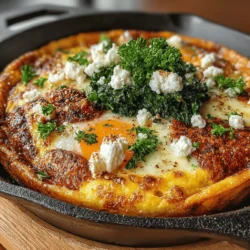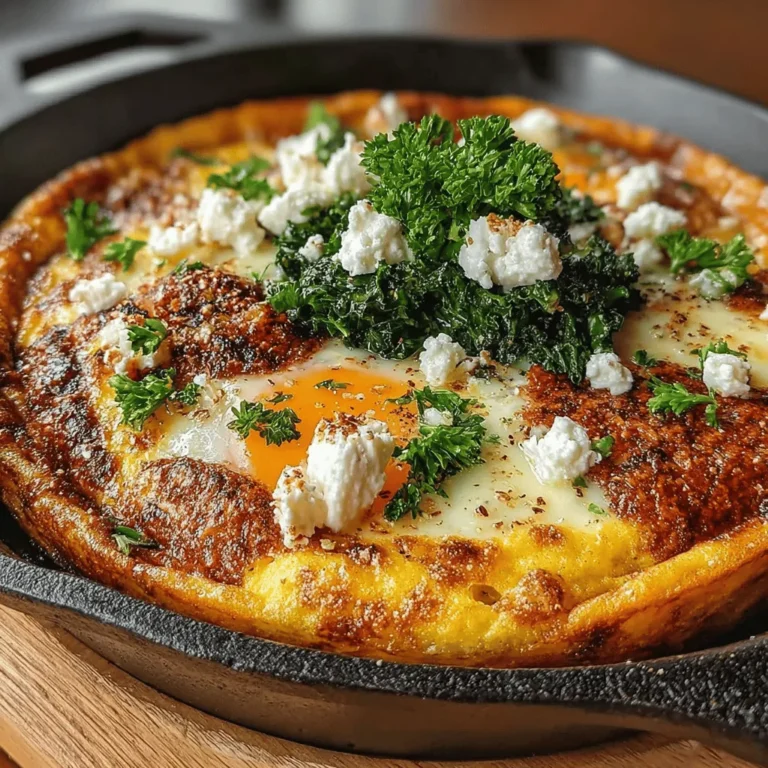Savory Pumpkin & Kale Frittata: A Wholesome Delight for Any Occasion
Frittatas are a versatile dish that can effortlessly transition from breakfast to brunch, lunch, or even a light dinner. Originating in Italy, frittatas are similar to omelets but are often cooked in a skillet and finished in the oven, allowing for a thicker and heartier meal. Their adaptability is one of their greatest strengths; you can fill them with a variety of ingredients, making them perfect for using up leftover vegetables or cheeses. In this recipe, we spotlight a delightful combination of pumpkin and kale, two ingredients that not only complement each other in flavor but also pack a nutritional punch.
The pairing of pumpkin and kale is particularly appealing for several reasons. Pumpkin, with its sweet and slightly earthy flavor, provides a rich base that balances beautifully with the robust and slightly bitter notes of kale. This frittata is not just a treat for your taste buds; it’s also an excellent choice for health-conscious individuals. Packed with vitamins and minerals, this dish is perfect for brunch gatherings, light dinners, or meal prep for busy weekdays.
Understanding the Ingredients
The Nutritional Benefits of Pumpkin
Pumpkin is often celebrated for its vibrant color and versatility, but it is also a powerhouse of nutrition. Rich in vitamins A and C, pumpkin supports eye health and boosts the immune system. Its high antioxidant content helps in fighting free radicals, making it a great addition to a balanced diet. Moreover, pumpkin is an excellent source of dietary fiber, aiding in digestion and promoting feelings of fullness. This makes it an ideal ingredient for those looking to maintain a healthy weight while still enjoying delicious meals.
The Health Benefits of Kale
Kale, on the other hand, is heralded as a nutrient-dense leafy green that has gained popularity in recent years. It is loaded with vitamins K, A, and C, making it a fantastic choice for promoting bone health and boosting overall immunity. Additionally, kale is high in antioxidants and has anti-inflammatory properties, which can contribute to better heart health. Its robust texture holds up well in cooking, providing not just nutrition but also a satisfying bite to the frittata.
The Importance of Eggs in a Frittata
At the core of any frittata are eggs, which serve as both a protein source and a binding agent. Eggs are incredibly versatile; they are rich in high-quality protein and contain essential amino acids that support muscle health and repair. When whisked together, eggs create a custard-like mixture that, when cooked, forms the perfect base for holding all the ingredients together in a cohesive dish.
The Flavor Profile of Feta Cheese
Feta cheese adds a tangy and creamy dimension to the frittata. This crumbly cheese not only enhances the flavor but also provides a contrast to the sweetness of the pumpkin and the earthiness of the kale. Its unique profile makes it a popular choice in various Mediterranean dishes, and it works wonderfully in this frittata, contributing a delightful creaminess that elevates the overall taste experience.
The Role of Aromatics: Onion and Garlic
Aromatics such as onion and garlic play a crucial role in enhancing the flavor and aroma of the dish. Sautéing these ingredients at the beginning of the cooking process releases their natural sweetness and depth, creating a flavorful foundation for the frittata. The warm, savory notes of these aromatics will permeate the entire dish, ensuring that each bite is infused with their rich character.
Seasoning with Thyme and Paprika
To further elevate the frittata, we season it with thyme and paprika. Thyme adds an earthy, herbaceous note that complements the other ingredients beautifully, while paprika introduces a subtle warmth and a hint of smokiness. Together, these seasonings create a well-rounded flavor profile that makes this frittata irresistible.
Preparation Steps for a Perfect Frittata
Prepping the Oven and Skillet
Before you begin cooking, it’s essential to prep both your oven and skillet. Preheat your oven to 375°F (190°C). This step is crucial for achieving even cooking and a perfectly set frittata. While the oven warms up, select a skillet that can transition from stovetop to oven. A cast-iron skillet is an excellent choice due to its heat retention and even cooking properties.
Sautéing Aromatics: The Foundation of Flavor
Once your skillet is ready, it’s time to sauté the aromatics. Begin by adding a drizzle of olive oil to the skillet over medium heat. Once the oil is shimmering, add finely chopped onions. Sauté them until they become translucent and slightly golden, about 5-7 minutes. Next, add minced garlic and continue to cook for an additional minute, stirring constantly to avoid burning. The aroma of the sautéing onions and garlic will fill your kitchen, setting the stage for the deliciousness to come.
Incorporating Kale: Techniques for Optimal Wilting
With the aromatics beautifully sautéed, it’s time to incorporate the kale. Add chopped kale to the skillet, stirring it into the onion and garlic mixture. Sauté until the kale wilts down, which should take about 3-5 minutes. To maintain the kale’s vibrant green color and texture, avoid overcooking it; you want the leaves to be tender yet still slightly crisp. If you find the skillet getting too dry, feel free to add a splash of vegetable broth or water to help steam the kale.
Creating the Pumpkin-Egg Mixture
While the kale is wilting, prepare the pumpkin-egg mixture. In a separate bowl, whisk together the eggs, crumbled feta cheese, and a pinch of salt and pepper. For added flavor, mix in your thyme and paprika. If you’re using canned pumpkin, ensure it’s pure pumpkin puree without added sugars or spices. If using fresh pumpkin, roast it first until tender, then mash it into a smooth consistency before adding it to the eggs. Gently fold the pumpkin puree into the egg mixture until well combined. This mixture will create a creamy and flavorful custard that binds all the ingredients together in the frittata.
Now that you have a solid foundation of flavor and the main components ready, you’re just a few steps away from assembling and baking your savory pumpkin and kale frittata. Stay tuned for the next part where we will guide you through the final steps to create this delicious dish!
{{image_2}}
Proper Whisking Methods for a Smooth Blend
To achieve a silky-smooth texture in your frittata, proper whisking is essential. Start by cracking your eggs into a mixing bowl and ensure they are at room temperature, as this helps them whisk more easily. Using a whisk, beat the eggs vigorously until the yolks and whites are fully combined, creating a uniform consistency. Aim for a fluffy texture by incorporating air into the mixture; this will contribute to the lightness of your frittata.
For those who prefer a richer frittata, consider adding a splash of milk or cream to the egg mixture. This not only enhances the flavor but also improves the creaminess. However, be cautious not to overdo it; a couple of tablespoons per egg is sufficient to maintain the frittata’s structure.
Combining Ingredients: Ensuring Even Distribution
Once your egg mixture is well whisked, it’s time to incorporate the sautéed pumpkin and kale. Make sure your vegetables have cooled slightly before adding them to avoid cooking the eggs prematurely. Pour the vegetable mix into the bowl with the eggs and gently stir using a spatula. This method ensures an even distribution of the kale and pumpkin throughout the frittata, allowing every bite to be flavorful.
Importance of Folding Versus Stirring
When combining the ingredients, it’s crucial to understand the technique of folding versus stirring. Folding is a gentle method that preserves the airiness of your egg mixture, which is vital for a light and fluffy frittata. To fold, use a spatula to scoop under the mixture and lift it over the top, rotating the bowl as you go. This technique helps maintain the volume of the eggs while evenly incorporating the vegetables.
Cooking Techniques for the Frittata
Initial Stovetop Cooking: What to Look For
After combining your ingredients, transfer the mixture to a preheated skillet over medium heat. The initial stovetop cooking is critical for setting the foundation of your frittata. Look for small bubbles forming at the edges of the frittata as it starts to cook. This is a good sign that the eggs are beginning to set.
Signs That the Edges Are Setting and the Center Is Starting to Firm
As the frittata cooks, keep an eye on the edges. You’ll notice them starting to pull away from the sides of the skillet. Additionally, the center should begin to firm up but still remain slightly jiggly. This is normal, as the frittata will continue cooking in the oven. Overcooking at this stage can lead to a dry frittata, so it’s essential to monitor the cooking process closely.
Baking Process: Achieving the Perfect Texture
Once the edges have set and the center is slightly jiggly, it’s time to transfer your skillet to a preheated oven. Baking is crucial for achieving that perfect frittata texture—fluffy and tender without being overly dry. Set your oven to 375°F (190°C).
Ideal Time and Temperature for a Well-Cooked Frittata
Bake the frittata for about 15-20 minutes. The ideal cooking time may vary slightly depending on your oven and the size of your skillet. To check for doneness, the frittata should be puffed up and golden brown on top, with no visible liquid egg remaining in the center. Remember, it will continue to cook slightly after being removed from the oven due to residual heat.
Visual Cues to Determine Doneness
To ensure your frittata is perfectly cooked, look for a few visual cues. The surface should be set and slightly golden, and when you gently shake the skillet, there should be minimal movement in the center. If you insert a toothpick or a knife in the center, it should come out clean, indicating that the frittata is set.
Serving Suggestions and Pairings
Ideal Times to Serve the Frittata
This savory pumpkin and kale frittata is incredibly versatile and can be enjoyed at any time of day. It makes an excellent brunch option, a light dinner, or even a meal prep solution for busy weekdays. Whether served warm or at room temperature, this dish is sure to impress.
Perfect for Brunch, Light Dinners, or Meal Prep
For brunch, pair it with a side of mixed greens and a light vinaigrette. For a light dinner, serve it alongside a crusty whole-grain bread or a refreshing salad. If you’re meal prepping, slice the frittata into wedges for easy grab-and-go lunches throughout the week.
Suggested Accompaniments
To elevate your frittata experience, consider serving it with accompaniments like cherry tomatoes, avocado slices, or a dollop of sour cream or Greek yogurt. These additions can enhance both flavor and texture, making your meal even more satisfying.
Pairing Ideas Like Salad, Whole-Grain Toast, or Fruit
When choosing sides, think about balance. A fresh arugula salad with lemon dressing complements the richness of the frittata beautifully. Whole-grain toast can add a nice crunch, while seasonal fruit, such as sliced berries or citrus, can provide a refreshing contrast to the savory dish.
Storing and Reheating Leftovers
Best Practices for Storing Frittata
If you have leftovers, storing them properly is key to maintaining their freshness. Allow the frittata to cool completely before storing. Cut it into individual portions and place them in an airtight container. This will help prevent it from drying out and preserve its texture.
Refrigeration Tips to Maintain Freshness
Store the frittata in the refrigerator for up to 3-4 days. For longer storage, consider freezing it. Wrap the individual slices tightly in plastic wrap and then place them in a freezer-safe bag or container. This method will help retain moisture and prevent freezer burn.
Reheating Methods for Optimal Taste and Texture
To reheat, you can use either the oven or a microwave. For the oven method, preheat to 350°F (175°C) and place the frittata in a baking dish covered with foil. Heat for about 10-15 minutes, or until warmed through. If using a microwave, place a slice on a microwave-safe plate and heat in 30-second intervals until heated to your liking.
Techniques to Avoid Drying Out the Frittata
To prevent the frittata from drying out during reheating, consider adding a splash of water or broth to the dish before covering it with foil. This helps create steam, which keeps the frittata moist and delicious.
Nutritional Information
Breakdown of Calories and Nutrients Per Serving
One serving of the savory pumpkin and kale frittata (approximately 1/8 of the recipe) contains around 180-220 calories, depending on the specific ingredients used. It provides a healthy balance of protein from the eggs, fiber from the kale and pumpkin, and essential vitamins and minerals.
Discussion on Dietary Considerations (e.g., Vegetarian, Gluten-Free Options)
This frittata is a fantastic option for vegetarians, packed with nutrients from seasonal vegetables. It can easily be made gluten-free by ensuring that any added ingredients (like spices or condiments) are certified gluten-free. Additionally, those looking to reduce cholesterol can substitute a portion of the eggs with egg whites or a vegan egg alternative.
Conclusion
The savory pumpkin and kale frittata is not only a delightful culinary creation but also a powerhouse of nutrition and flavor. With its rich, earthy taste and vibrant colors, this dish stands out as a satisfying meal option any time of day. The adaptability of the frittata allows you to experiment with various ingredients, making it a perfect canvas for your culinary creativity.
Whether you’re looking for a hearty brunch dish, a light dinner, or a meal prep solution, this frittata offers both nutrition and versatility. We encourage you to try this recipe and make it your own by incorporating different vegetables or spices that suit your taste. Enjoy the rich flavors and the healthy benefits that come with this delightful dish, and share it with family and friends to elevate their dining experience as well.


